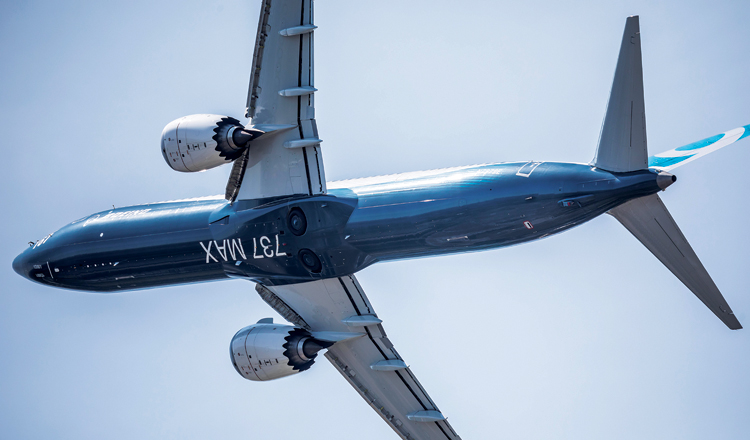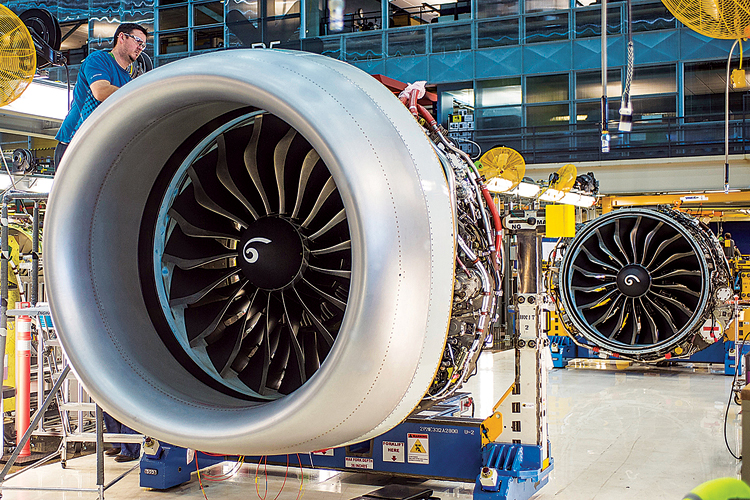INDIAN ARMED FORCES CHIEFS ON OUR RELENTLESS AND FOCUSED PUBLISHING EFFORTS

The insightful articles, inspiring narrations and analytical perspectives presented by the Editorial Team, establish an alluring connect with the reader. My compliments and best wishes to SP Guide Publications.

"Over the past 60 years, the growth of SP Guide Publications has mirrored the rising stature of Indian Navy. Its well-researched and informative magazines on Defence and Aerospace sector have served to shape an educated opinion of our military personnel, policy makers and the public alike. I wish SP's Publication team continued success, fair winds and following seas in all future endeavour!"

Since, its inception in 1964, SP Guide Publications has consistently demonstrated commitment to high-quality journalism in the aerospace and defence sectors, earning a well-deserved reputation as Asia's largest media house in this domain. I wish SP Guide Publications continued success in its pursuit of excellence.
LEAP-1B Powering the Boeing 737 MAX
The first engine delivery to Boeing took place in October 2015 and the first Boeing 737 MAX 8 with a LEAP-1B engine flew on January 29, 2016

Since the 1990s, Airbus and Boeing have reigned over the large airliner market in a neck and neck race. In the narrow body, single-aisle market segment, the Airbus A320 family and Boeing’s 737 family, have ruled the roost in a closely and sometimes bitterly contested duopoly. Insubstantial improvements and enhancements have kept the race interesting from the point of view of the user airlines until, at the beginning of this millennium, it became apparent that a bigger leap was required to provide the narrow-body airliner with more substantial improvements.
The space between narrow and wide-body airliners became a work sheet on which both contenders intensely worked to find solutions that would attract new customers. Both Airbus and Boeing decided that re-engining the existing Airbus A320 and Boeing 737 supplemented by some other design and material changes, could give a substantial fillip to cost effectiveness of the existing families; the Airbus A320neo and Boeing 737 MAX were the new versions. Airwaysnews.com, an aviation magazine, hailed this initiative as the “Age of Incrementalism” characterised by major original equipment manufacturers (OEMs) avoiding the massive investment and risk involved in developing clean sheet aircraft and favouring the safer option of reengining existing and proven models. This article deals with the Boeing 737 MAX family and Boeing’s power plant choice for the Boeing 737 MAX series, the CFM’s LEAP-1B power plant.
The 737 MAX series

| 737 MAX 7 | 737 MAX 8 | 737 MAX 9 | 737 MAX 10 | |
| Seats (2-class) | 138 – 153 | 162 – 178 | 178 – 193 | 188 – 204 |
| Maximum seats | 172 | 200 | 220 | 230 |
| Range nm (km) | 3,825 (7,080) | 3,515 (6,510) | 3,515 (6,510)* | 3,215 (5,960)* |
| Length | 35.56 m (116 ft 8 in) | 39.52 m (129 ft 8 in) | 42.16 m (138 ft 4 in) | 43.8 m (143 ft 8 in) |
| Wingspan | 35.9 m (117 ft 10 in) | 35.9 m (117 ft 10 in) | 35.9 m (117 ft 10 in) | 35.9 m (117 ft 10 in) |
| Engine | LEAP-1B from CFM International | LEAP-1B from CFM International | LEAP-1B from CFM International | LEAP-1B from CFM International |
| 200 seats: 737-8-200 | *one auxiliary tank | *one auxiliary tank |
Source: http://www.boeing.com/commercial/737max/
Background
CFM International, a 50-50 joint venture company between GE Aviation of the United States and Safran Aircraft Engines (formerly Snecma) of France started the LEAP (Leading Edge Aviation Propulsion) programme in 2005 incorporating technologies that CFM developed as part of its LEAP56 technology acquisition programme. The engine was officially launched as LEAP-X on July 13, 2008, as an intended successor to the CFM56 family popular with contemporary narrow-body, single-aisle aircraft. The other contender for that segment is the Pratt & Whitney PW1000G engine. The LEAP family has three siblings: 1A which powers the Airbus A320neo and produces 24,500 to 35,000 lbs thrust, 1B for the Boeing 737 MAX family which produces 23,000 to 28,000 lbs thrust and 1C for the Chinese COMAC C919 with 27,890 to 30,000 lbs thrust. At the 2011 Dubai Air Show, CFM announced that Boeing had selected the LEAP-1B as the exclusive power plant for the Boeing 737 MAX family. This was a setback for Pratt & Whitney which had been hoping to get an entry into the MAX programme as a peer to the CFM LEAP-1B just as it had done for the Airbus A320neo with the CFM LEAP-1A. Boeing has been steadfast since then in sticking to the LEAP-1B as the sole engine for all versions of the Boeing 737 MAX.
However, re-engining for the Boeing 737 MAX was not a simple engineering exercise. The Boeing 737 was designed in the 1950s with the CFM 56 engine with a 61 inch fan diametre for the 737NG variants and the low airframe was very convenient for carrying out servicing activities thus facilitating short turn round time. The bigger size of the new engine was a challenge as the clearance constraint was just 83 inches which had been suitable for the CFM 56 family; but the LEAP engines were larger. The LEAP-1A, a more powerful variant than the LEAP-1B, had a fan diameter of 78 inches and so had to be ruled out. Even the LEAP-1B (the choice in 2011 was between 66 and 68 inches fan diametre for LEAP-1B) proved to be a daunting engineering problem and the undercarriage had to be lengthened to cater for the LEAP-1B as a 17-inch clearance was considered minimum from safety and operational considerations. In November 2011, Boeing selected the larger fan diametre of 68 inches, necessitating an eight inch longer nose landing gear. Major and costly modifications to the wing box housing were evaded by cantilevering the new engine up and forward which, in conjunction with the nose gear extension, sufficed to house the LEAP-1B. However, in May 2012, it was decided to enlarge the fan diametre to 69.4 inches.

By mid-2013, a design freeze was announced and ground testing commenced in mid-2014 as a first step towards engine certification. The first engine start up was done on June 13, 2014 and the first flight on a Boeing 747 flying test bed was carried out on April 29, 2015, at GE’s flight test centre in California. The first engine delivery to Boeing took place in October 2015 and the first Boeing 737 MAX (a MAX 8) with a LEAP-1B engine flew on January 29, 2016. The engine was granted a certification jointly by the Federal Aviation Administration (FAA) and the European Aviation Safety Agency (EASA) in May 2016, which paved the way for entry into commercial service. However, in May 2017, Boeing announced that, “CFM has notified us of a potential manufacturing quality escape with low pressure turbine (LPT) discs in LEAP-1B engines delivered to Boeing.” Flying was stopped for a few days and then recommenced on the unaffected engines. The first delivery was to Malindo Air and the Boeing MAX 8 entered service on May 22, 2017. Norwegian Air International was the second airline to put a Boeing 737 MAX into service, when it performed its first transatlantic flight with a Boeing 737 MAX 8 on July 15, 2017, between Edinburgh in Scotland and Hartford International Airport in the US. By this time it had been given Extended Range Twin-Engine Operations (ETOPS) clearance for 180 minute flights.
The MAX Family
The first member of the MAX family to fly was the Boeing 737 MAX 8, but the family has three other versions (details in the table). It is offered in four lengths, the Boeing 737 MAX 7, MAX 8 and MAX 9 replacing the Boeing 737-700, -800 and -900 of the 737 NextGen (or NG) family; a further stretched Boeing 737 MAX 10 has also been launched as according to Boeing, the most cost-effective single-aisle airliner with 230 seats.
THE LEAP-1B CONTINUES TO ENJOY THE STAT US OF THE ONLY ENGINE TO POWER THE BOEING 737 MAX FAMILY OF AIRLINERS
All versions are powered by the LEAP-1B engine but their appearance is not in the digital order of their versions. The Boeing 737 MAX 8 was the first one to make its debut with a first flight in January 2016 and has entered commercial service while the Boeing 737 MAX 9 flew first in April 2017. The Boeing 737 MAX 7 is expected to enter service in 2019 and the Boeing 737 MAX 10 in 2020; both have been officially launched by Boeing. These are the four current versions according to the Boeing website, but in the past a Boeing 737 MAX 200 (refer table, under MAX 8) was spoken of in conjunction with Ryanair and a Boeing 737-8ERX, a long range version of the Boeing 737 MAX 8 was shown as a concept by Boeing in the past.
Conclusion
Last year, there were reports about Boeing considering the potential use of the larger LEAP-1A (fan diametre 78 inches) to re-engine a further stretch of the Boeing 737 MAX (with at least four more rows added) as an endeavour to provide yet another option to potential customers in competition to the Airbus A320neo family. This version was referred to by reports as Boeing 737 MAX 10. But now it is evident that the Boeing 737 MAX 10 houses a LEAP-1B engine. While the increased thrust of the LEAP-1A would cater to the increased payload, fitting the LEAP-1A would be a challenge as the modifications carried out for housing the LEAP-1B are inadequate to accommodate the LEAP-1A on account of its larger size. Not much has been heard after that of a MAX version with LEAP-1A, possibly due to Boeing considering a ‘Middle of the Market’ new design to fill the gap between narrow and widebody aircraft currently flying around the world. Meanwhile, the LEAP-1B continues to enjoy the status of the only engine to power the Boeing 737 MAX family.





